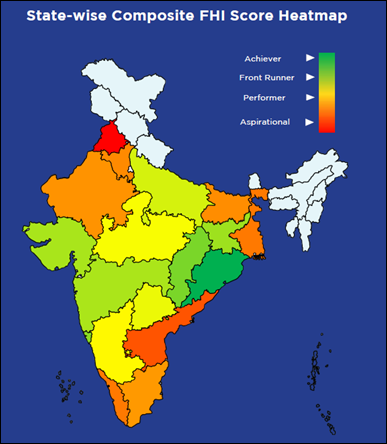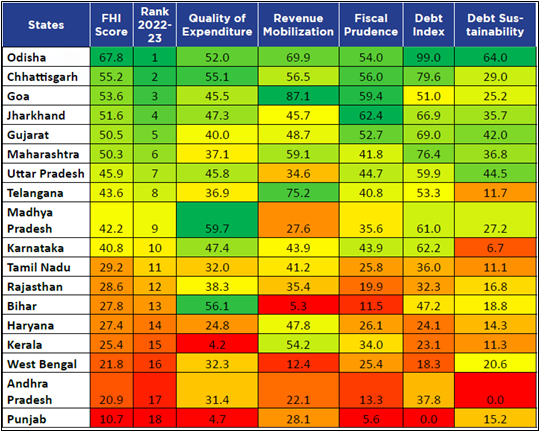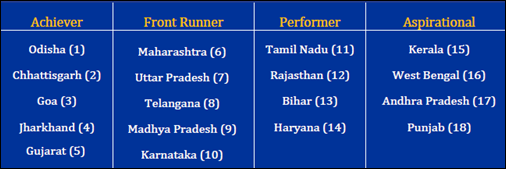Ministry of Information & Broadcasting
Fiscal Health Index 2025
Mapping India's State-Level Economic Resilience
प्रविष्टि तिथि:
02 APR 2025 5:42PM by PIB Delhi
Introduction
The Fiscal Health Index (FHI) initiative by NITI Aayog aims to evolve an understanding of the fiscal health of states in India. The FHI analysis covers eighteen major states that drive the Indian economy in terms of their contribution to India’s GDP, demography, total public expenditure, revenues, and overall fiscal stability. Odisha leads the Index, followed by Chhattisgarh, Goa, Jharkhand and Gujarat. As states are responsible for approximately two-thirds of public spending and one-third of total revenue, their fiscal performance is important for the country’s overall economic stability. The report objectively evaluates each state’s fiscal health through a composite index, facilitating comparisons and benchmarking against best practices. The composite Fiscal Health Index has been developed using data from the Comptroller and Auditor General of India (CAG), covering the Financial Year 2022-23.

Objectives of the Fiscal Health Index
- To provide a comparative analysis of fiscal health across Indian states through standardized metrics.
- To identify areas of strength and concern in states' fiscal management practices.
- To promote transparency, accountability, and prudent fiscal management through empirical assessment.
- To assist policymakers in making informed decisions aimed at enhancing fiscal sustainability and resilience.
Key Indicators Evaluated
The Fiscal Health Index 2025 is based on a comprehensive set of indicators that are grouped into five broad categories:
-
Tax Buoyancy
Tax buoyancy is a ratio of change in tax revenue in relation to change in gross state domestic product or GSDP of a state. It measures how responsive a taxation policy is to growth in economic activities.
|
Revenue Generation and Mobilization: Assessment of states' own revenue receipts, tax buoyancy, and non-tax revenue generation.
-
Debt-to-GSDP
The debt-to-GDP ratio is a metric that compares a state’s total public debt to its gross state domestic product (GSDP), indicating its ability to repay its debts, and is often expressed as a percentage.
|
Expenditure Management and Prioritization: Evaluation of efficiency in expenditure allocation, prioritization of capital expenditure, and adherence to fiscal discipline.
- Debt Management: Analysis of states’ debt-to-GSDP ratios, interest payment burdens, and overall sustainability of debt portfolios.
- Fiscal Deficit Management: Measurement of states’ fiscal deficit as a percentage of Gross State Domestic Product (GSDP) and adherence to statutory limits.
- Overall Fiscal Sustainability: Composite analysis of revenue, expenditure, deficit, and debt indicators to gauge long-term fiscal health.
Key Findings

Odisha leads the fiscal health index with a top score of 67.8, excelling in the Debt Index (99.0) and Debt Sustainability (64.0). It maintains low fiscal deficits, a strong debt profile, and a high Capital Outlay/GSDP ratio. Chhattisgarh (55.2) and Goa (53.6) follow, excelling in Debt Index and Revenue Mobilization, respectively. Odisha, Jharkhand, Goa, and Chhattisgarh excel in non-tax revenue mobilization, averaging 21% of Total Revenue, with Odisha benefiting from mining premiums and Chhattisgarh from coal block auctions. Conversely, Punjab, Andhra Pradesh, West Bengal, and Kerala face significant fiscal challenges, including low expenditure quality, poor debt sustainability, and high fiscal deficits. States like Madhya Pradesh, Odisha, Goa, Karnataka, and Uttar Pradesh allocate around 27% of their Developmental Expenditure to Capital Expenditure, while West Bengal, Andhra Pradesh, Punjab, and Rajasthan allocate only about 10%. While top states excel in Debt Index and Sustainability, West Bengal and Punjab struggle with rising debt-to-GSDP ratios, raising concerns about debt sustainability.
Sustainability of Debt Portfolios
Sustainability of debt portfolios refers to state’s ability to meet its current and future debt obligations without defaulting or requiring exceptional financial assistance, focusing on both solvency and liquidity.
|
- Top Performers: Odisha, Chhattisgarh, and Goa excel in Debt Index, Debt Sustainability, and Revenue Mobilization.
- Revenue Mobilization: Odisha, Jharkhand, Goa, and Chhattisgarh effectively mobilize non-tax revenue (average 21% of Total Revenue).
-
Debt Index
The ratio of Interest Payments to Revenue Receipts (IP/RR) indicating the percentage of Revenue Receipts used for interest payment on account of outstanding debt.
|
Aspirational States: Punjab, Andhra Pradesh, West Bengal, Kerala face fiscal challenges like poor debt sustainability and high deficits.
- Capital Expenditure: High allocation (27%) by Odisha, Goa, Madhya Pradesh, Karnataka, Uttar Pradesh; Low allocation (10%) by West Bengal, Andhra Pradesh, Punjab, Rajasthan.
- Debt Concerns: West Bengal and Punjab face growing debt burdens and increasing debt-to-GSDP ratios.

Conclusion
The Fiscal Health Index 2025 offers a valuable tool for assessing the fiscal performance of Indian states. It highlights the need for continuous monitoring, prudent fiscal management, and proactive measures to enhance states' financial health. The Index underscores the importance of revenue generation, efficient expenditure management, debt control, and adherence to fiscal deficit targets for overall fiscal sustainability. The FHI report has been shared with all States/UTs to help them evaluate their fiscal performance across key indicators. States are encouraged to adopt sustainable fiscal practices suited to their economies and work towards fiscal prudence through appropriate state-level interventions
References
https://www.niti.gov.in/sites/default/files/2025-01/Fiscal_Health_Index_24012025_Final.pdf
https://sansad.in/getFile/loksabhaquestions/annex/184/AU5286_7JIvqM.pdf?source=pqals
Fiscal Health Index 2025
****
Santosh Kumar | Ritu Kataria | Rishita Aggarwal
(रिलीज़ आईडी: 2117890)
आगंतुक पटल : 13193